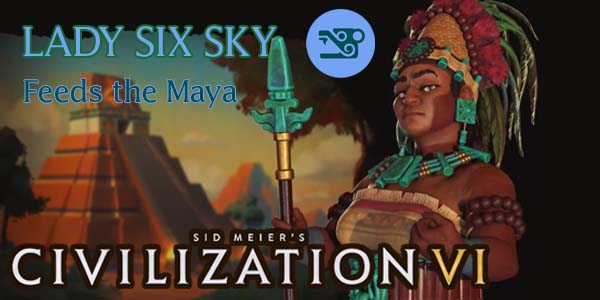
Firaxis will be releasing Civilization VI DLC packs with new game modes, new civilizations, and new leaders through March of 2021. The first such "New Frontiers" pack released in May of 2020 and included two new civilizations: the Maya and Gran Colombia.

For future releases that include multiple leaders or civilizations, I may put up polls on Patreon to let my Patrons decide which civ or leader to cover first (if Firaxis gives enough advance notice). I may also put up polls asking if my Patrons would prefer that I make guides focused on the new game modes. So if you would like to vote on which content you would prefer to see sooner, I hope you'll consider supporting the creation of this content on Patreon.
The group of peoples collectively known as the "Maya" occupied the Yucatán region of Central America. The Maya never unified under a singular state, instead consisting of a variety of theologically-governed chiefdoms and city-states, whose elites engaged in court intrigue against each other. Despite never being unified, the culture is well-known for its sophisticated writing, architecture, mathematics, astronomical observations, and its calendar system.
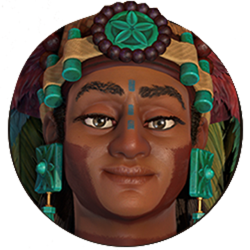
The Maya are perhaps most famous in popular culture for their "mysterious" disappearance, but this is mostly the result of popular misconception. It is true that large, classical Mayan cities were abandoned in the 8th and 9th centuries, but the decline is more gradual, and the civilization did not suddenly collapse overnight. Its population and power centers simply migrated north, where the Maya continued to flourish until the Spanish conquistadors conquered them. Though the exact cause(s) of the decline and migration is still a hotly disputed topic of modern archaeology. It is very likely that environmental factors played a large role, as the Maya built many of their cities in dense jungle, with thin soil and limited access to water, where they would be highly susceptible to drought and disease. In fact, the decentralized nature of the Maya allowed many remote Mayan villages to survive the Spanish conquests barely aware that anything had happened. Because of this, more than 6 million Mayan descendants still occupy the ancestral lands and speak Mayan languages.
Wak Chanil Ajaw (also known as Lady Six Sky) was the daughter of the chieftain of the city of Dos Pilas who's marriage was arranged with a prince of Naranjo in order to bring Naranjo into the Calakmul–Dos Pilas alliance. In the meantime, however, Naranjo engaged in its own conquests, and by the time Lady Six Sky took over as ruler of Naranjo (possibly as an informal regent for her son), Naranjo already had its own small empire going. As queen regent, she is believed to have acted as a warrior queen, and went on to successfully conquer several other Mayan city states. Her victories are depicted on several surviving monuments.
DISCLAIMER:
Civilization VI is still a "living game". Strategies for the game (and for specific leaders and civs) may change as Firaxis applies balance patches, introduces new features, or expands the game through further DLC or expansion packs, or as the Civ community discovers new strategies or exploits. As such, the following strategy guide may change from time to time. I will try to keep it up-to-date, and will make notations whenever changes are made. I'll also post links in the official 2K forums and CivFanatics, where I'll also report any changes made. If possible and practical, I will try to retain the original content of the strategy for posterity.
I welcome any feedback or suggestions that readers wish to offer. Feel free to post on the linked forums, or by posting a comment at the bottom of the page.
This guide is up to date as of the release of the "New Frontiers" August 2020 Update (ver. 1.0.4.8)
Lady Six Sky likes to build a tightly-packed core of highly-defensible cities improved with farms and plantations to feed her population. Cities that she builds or conquers beyond this tightly-packed core will less productive. [More]
8e30db96-fdf6-4db0-a88d-006411a6c91a|0|.0
Tags:Sid Meier's Civilization, Civilization VI, Maya, Lady Six Sky, ix mutal ajaw, mayab, observatory, hul'che, solitary, campus, science, plantation, farm, housing, amenity, capital
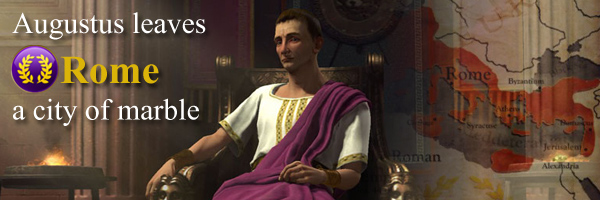
I've already covered strategies for the civilizations that have been added or explicitly changed in the Brave New World expansion and its major fall (2013) patch. Now I'm going to move on to other legacy civilizations that have not had explicit changes, but who may have had their strategies significantly altered by the expansions and other updates. This time, I will be covering one civ that surprisingly does not benefit from Brave New World's new mechanics as much as one might think: the Roman Empire.
Rome is one of the most influential and heavily romanticized cultures of the classical world. The early Roman republic was a system of semi-democratic representational government. Power was divided between two consuls who were annually elected by the citizens and alternated as military leaders to check each others' ambitions, while an appointed body of senators directed foreign policy and enacted laws. The city gradually expanded its power and influence in the second half of the first millennium BC through the overwhelming success of its legionary forces and defeat of its primary rival Carthage, until it eventually came to control almost the entire Mediterranean. Rome itself became the center of government and commerce for most of Europe, and it established an elaborate network of roads, aqueducts, and other engineering feats.
The Roman government was generally very tolerant of foreign religions and cultures, which helped to pacify subjugated peoples. But as Rome became an empire, and its holdings expanded, this tolerance became a liability. Foreign peoples were allowed admittance into the army in order to secure Rome's ever-increasing borders, which lead to a decline in loyalty to Rome as the army became more diverse and less centralized. Eventually, generals would begin competing with each other for control of Rome and the title of emperor, weakening the empire from within and making it vulnerable to external threats such as immigrating Germanic tribes displaced by the Huns. Eventually, these threats would culminate in the sacking of Rome by the Visigothic leader Alaric in August of 410 AD, and the collapse of the Western Roman Empire. However, the eastern half of the empire, also known as the Byzantine Empire, would continue to carry the torch of Rome for another thousand years.

After the death of Julius Caesar, his adopted nephew and heir, Gaius Octavius, along with Marc Antony and Marcus Lepidus, tracked down and defeated Brutus, Cassius, and the other assassins who had conspired against Caesar. This new triumvirate quickly disintigrated into civil war, with Octavius decisively defeating both Lepidus and then Antony and holding sole authority over a new Roman Empire. He changed his name to Caesar in honor of his adopted uncle, and reinstated the Roman senate as a puppet facade government to legitimize his dictatorial leadership. He was extremely popular among the Roman citizens due to his relation to Julius, and was eventually honored with the title Augustus. He instituted numerous domestic reform including official police and fire-fighting services, engineering projects such as roads, and expanded the dominion of Rome in Africa, Hispania, and Germania. Octavius found Rome a city of bricks; Augustus left it a city of marble, and the envy of the western world. [More]
d459e477-29a8-4c05-a582-9bfa0d6c216a|2|5.0
Tags:Sid Meier's Civilization, Civilization V: Brave New World, Civilization V, Rome, Augustus Caesar, Legion, Ballista, Glory of Rome, production, trade route, capital, swordsman, catapult, Civ-V
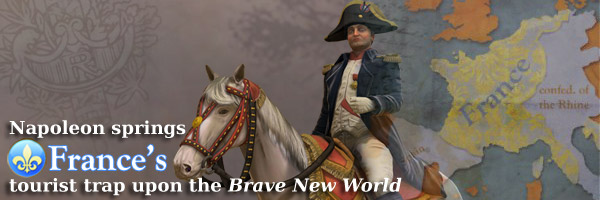
Now that I've finished my series of strategy posts about Brave New World's new civilizations, I want to take some time to look into some of the legacy civs that have received updates since Brave New World. France received a major revision in Brave New World out of the box, having its national trait completely redesigned, and one of its unique units was replaced with a powerful new unique improvement.
Humans have been occupying the land of France for at least 1.8 million years. The caves of Lascaux are a famous paleontological / archaeological site, as its cave paintings are some of the earliest and best-preserved examples of early human art and culture. After the fall of the Roman Empire, the region was split up between numerous Germanic tribes. One Germanic group, the Franks, eventually came to control most of the region, and this is where the term "France" was eventually derived. They set up the first French Kingdoms, which gained strength during the medieval periods despite threats from the Vikings and English. The European Enlightenment can trace many of its roots to the intellectual circles of France, which eventually culminated in the French Revolution that deposed and executed King Louis XVI and established a fledgling Republic.

Napoleon Bonaparte seized control of this young Republic in 1799, eventually declaring himself the Emperor of France. He was a military genius of the time and an expert in the use of artillery. He conquered much of Europe from Spain all the way to Russia, and even fought campaigns in Africa (although these campaigns were not successful). His conquests helped to spread French culture, ideals, and reforms around the world, including widespread adoption of the metric system, new military traditions, and the Declaration of the Rights of Man. His armies eventually fell victim to the harsh Russian winters, which halted Napoleon's aggressions and forced a withdrawl. His reign eventually culminated in a devastating defeat at Waterloo (then part of the United Kingdom of the Netherlands). He was forced into exile on the island of Saint Helena, where he eventually died of stomach cancer in 1821.
One of Napoleon's nephews, Louis-Napoleon Bonaparte (Napoleon III), launched an enormous public works program in Paris in the mid 1800's in order to build hundreds of kilometers of wide boulevards and streets, replace the sewer system, construct parks, and be the first city in the world to install artificial lighting (originally oil-lit lanterns). This made Paris into the world's first "City of Light", allowing people to work and engage in recreational activities around the city during the night, eventually establishing a 24-hour culture and the urban nightlife.
[More]
9f3d3eec-89be-41a6-a1c0-4bd688440079|8|3.0
Tags:Sid Meier's Civilization, Civilization V: Brave New World, Civilization V, great work, theming bonus, luxury resource, Ancient Regime, France, unique improvement, Napoleon, City of Light, Chateau, Musketeer, Foreign Legion, Paris, tourism, culture, wonders, capital, Musketman, Civ-V
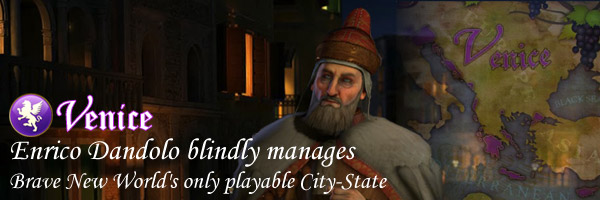
The penultimate entry in my series of strategy posts about Brave New World's new civilizations will focus on the very unique civilization of Venice: the playable City-State.
The city of Venice is one of the most architecturally astounding cities in the world. It is built on top of 118 small islands in the marshy Venetian lagoon. These natural and artificial islands are separated by a network of canals that run through the city and act almost like a network of roads. Many of the buildings and paved surface roads and walkways are built on top of stilts that emerge from these shallow canals and the city contains over 400 bridges. Historically, most of Venice's traffic has been through the waterways (via gondole) or on foot, but the modern city does have a contemporary road network (although a very compact one) intended for automobiles. Due to its unique environment and construction, the city is an astounding work of engineering art in and of itself.
There are no surviving historical records depicting the founding of Venice, but historians believe that the islands were originally settled by refugees from Roman cities during the Germanic and Hunnic invasions between 400 and 600 C.E. Venice began to expand its international influence prior to the thirteenth century by battling pirates that were plaguing trade in the Adriatic and Mediterranean. The city-state began to become an influential economic force in the region due to its position as a hub for trade between Europe and the Middle East, and Venice non-violently acquired control over many islands of the Aegean, including Cyprus and Crete. Failed military actions and the devastation of the black plague in the fifteenth century lead to the decline of the Venetian empire, and Venice was eventually conquered by Napoleon, then surrendered to Austria in the terms of a peace treaty, then conquered again by Italy during its war of independence. Fortunately, Venice was spared from attack during World War II, and so much of its historical architecture has remained intact, making it a popular tourist destination today.
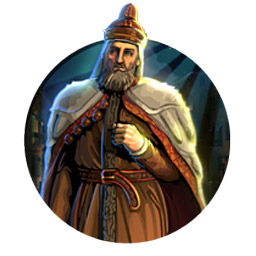
The 42nd Doge of Venice, Enrico Dandolo is known mostly for his blindness. There are conflicting stories regarding how Dandolo became blind. The decreasing legibility of his signature between 1174 and 1176 implies that he became blind gradually, possibly due to an injury sustained in Constantinople. He was also a very pious leader who provided invaluable assistance to the knights of the Fourth Crusade and played an integral part in the eventual sacking of Constantinople. Despite his blindness, Dandolo survived into extreme old age, being almost a hundred years old (by some estimates) at the time of his death in 1205. He was buried in the Hagia Sophia in Constantinople, but his original tomb was destroyed by the Ottomans when they captured Constantinople (renamed it Istanbul) and converted the Hagia Sophia into a mosque.
Venice was a City-State in Gods & Kings but was promoted to a full civilization for Brave New World. Venice doesn't expand like a traditional civ in Brave New World; instead, it buys control of fellow City-States or expands its influence via conquest, both of which are funded by its excessive trade routes. [More]
68d21b21-5812-4863-90c6-b12e9b6ac21b|13|4.9
Tags:Sid Meier's Civilization, Civilization V: Brave New World, Civilization V, Venice, Enrico Dandolo, Serenissima, Merchant of Venice, Great Galleass, trade, trade route, caravan, cargo ship, navy, puppet, warmonger, gold, commerce, Great Merchant, galleass, city state, capital, Civ-V
|

| 12 | | | | | | | 60 | | 11 | | | | | | | 55 | | 10 | | | | | | | 50 | | 09 | | | | | | | 45 | | 08 | | | | | | | 40 | | 07 | | | | | | | 35 | | 06 | | | | | | | 30 | | 05 | | | | | | | 25 | | 04 | | | | | | | 20 | | 03 | | | | | | | 15 | | 02 | | | | | | | 10 | | 01 | | | | | | | 05 |
|